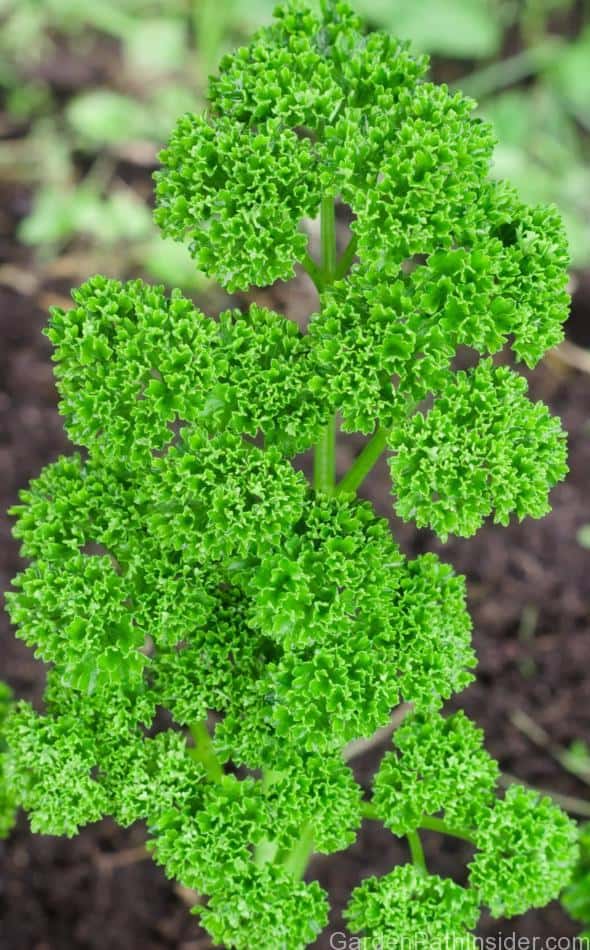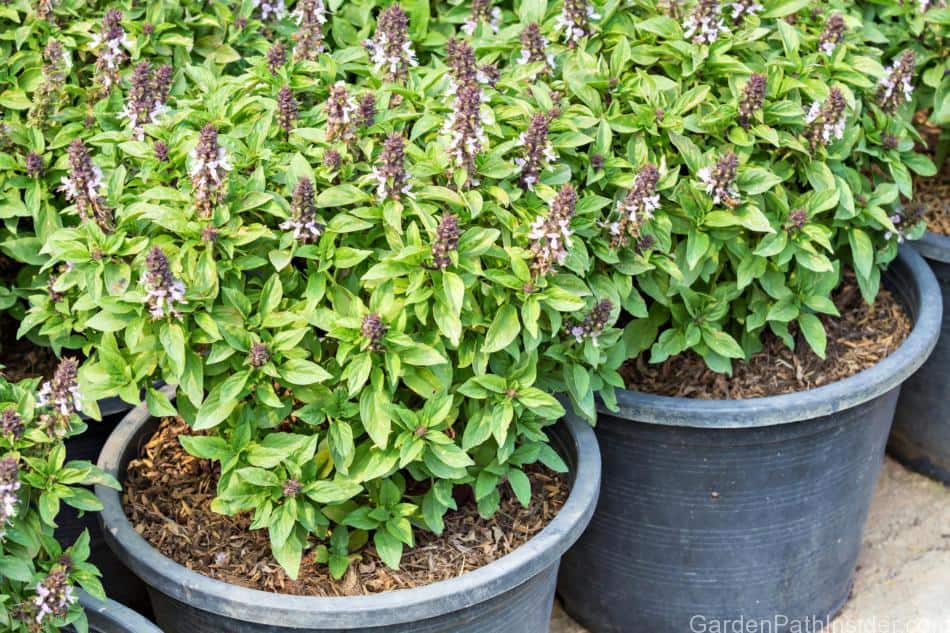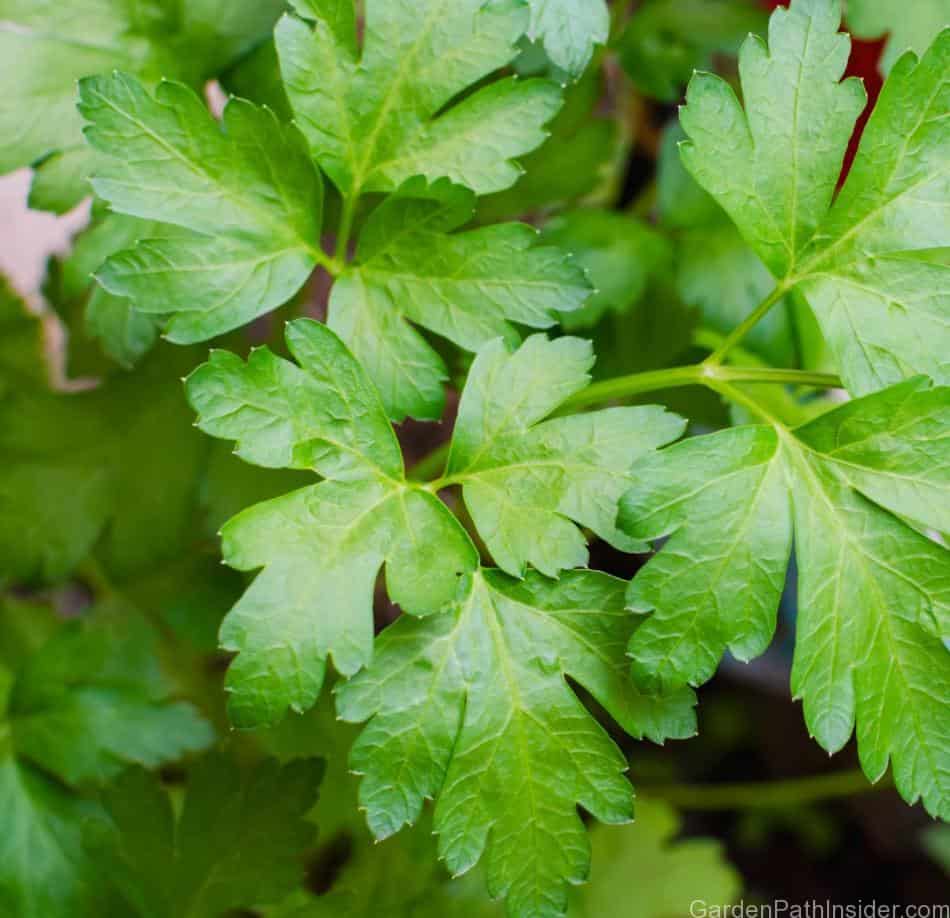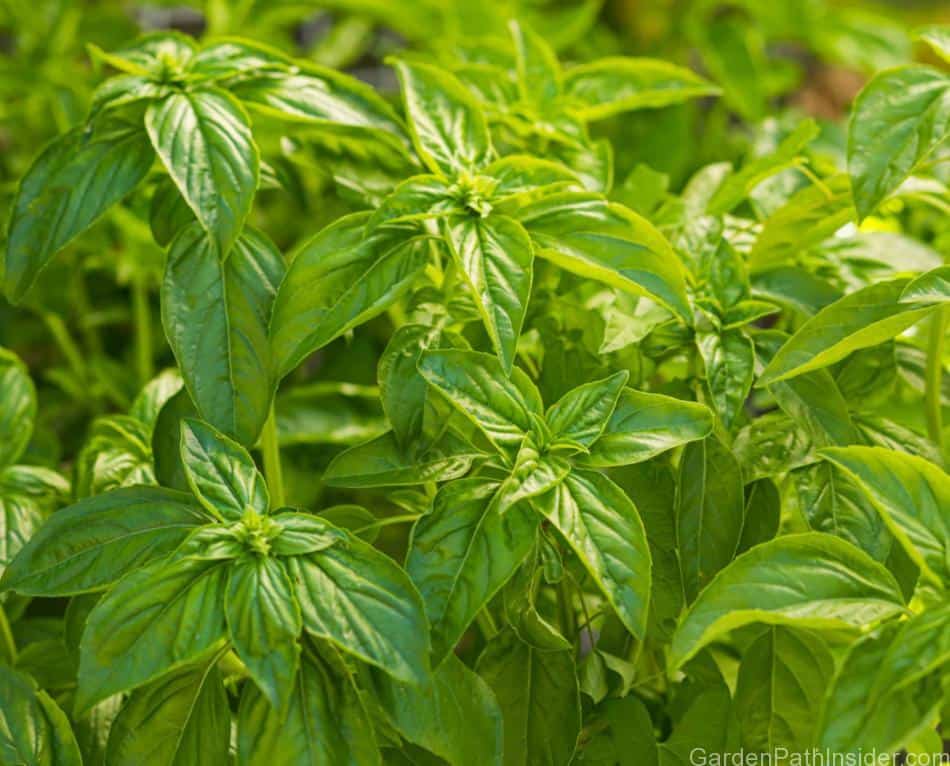
Fresh basil and parsley thrive in any herb garden as companion plants. Both basil and parsley have flavorful leaves that can be harvested year-round when grown indoors. When grown outdoors both herbs provide multiple harvests each season.
Basil and parsley can be planted together in the same container or gardening bed, as both plants require identical growing conditions of full sun and moist nutrient-rich soil. Basil and parsley are great companion plants, as parsley repels insect pests that may damage the delicate basil plant.
Growing parsley and basil as companion herb plants is a great introduction to herb gardening. Below we outline the optimal growing conditions for your new companion planting herb garden.
Basil and Parsley Companion Planting
Basil and parsley are companion plants that can be efficiently grown side by side in a shared growing space.
Basil and parsley require identical growing conditions for soil fertility, sunlight requirements, and water requirements. We will cover these growing conditions below.
Basil leaves grow on tall thin stems. As the plant grows during the season the roots spread slightly and the basil cluster grows larger. Parsley grows in groupings of tall stalks and spread slightly through the garden by dropping seeds that sprout new growth around the parent grouping.
Basil and parsley in a shared growing space should be planted about 8 inches apart (20.32 cm). This space gives each plant’s roots enough room to spread and develop without choking the other plant out.
Related article: Can Basil and Rosemary Be Planted Together?
Interested in starting your companion herb garden? See our article resource on growing rosemary as a companion plant to basil. Rosemary is a wonderful kitchen herb that can be incorporated into savory dishes like, flatbreads, chicken, pasta, and even pizza.
Read more here: Can Basil and Rosemary Be Planted Together?
Cover image details: Seedlings of Basil in a ceramic pot© derketta776/123rf.com

Parsley Varieties
Parsley is grown for its flavorful leaves that are used in Mediterranean dishes, and also it is used as a garnish.
Parsley is a hardy annual that can withstand cold climates and harsh winters. The parsley plant will grow flowers that bloom and drop seeds around the parent plant. The seeds that are dropped at the end of the growing season will remain dormant over the winter and sprout new life in the spring months of the following season.
Parsley is broken into two categories, Leaf parsley, and Root parsley.
Leaf parsley has two well-known varieties: French parsley commonly known as curly leaf parsley (Anthriscus cerefolium), and Italian parsley commonly known as flat-leaf parsley (Petroselinum crispum var. neapolitanum).
Curly leaf parsley is used more often in culinary dishes due to its elegant shape and presentation. Curly leaf (French) parsley is used in many culinary dishes like tabbouleh and used as a garnish on steak, fish, chicken, and many other dishes.
Root parsley (Hamburg Parsley) looks like a white carrot and is eaten raw and used in soups and stews.
Basil Varieties
Basil is an annual plant grown for its large flavorful and tender leaves.
Basil reaches heights of around 36 inches tall (91cm) and blooms during spring and summer.
Basil requires day-time temperatures around 60°F to 70°F (15°C to 21°C) and night-time temperatures around 45°F to 50°F (7°C to 10°C).
Basil is not a hardy plant. If basil is grown outdoors, plant in late spring after the final frost. If growing basil in pots, bring in the potted basil before the end of season frosts.
There are several species of basil. Basil can vary from species to species by flavors and the scents of the leaves. To avoid cross-pollination between basil varieties, plant one variety per pot or garden plot. If the plants cross-pollinate the individual characteristics of each plant will blend together making their flavor-notes indistinguishable from one another.
Below are some of our favorite Basil species to use in the kitchen:
- Sweet basil (Ocimum basilicum)
- Lime basil (Ocimum x africanum ‘Lime’)
- Italian Large Leaf Basil (Ocimum basilicum L)
Sweet basil is by far the most popular variety and can be found in any garden store during the growing season. Our container garden always includes at least one variety of tomato in addition to a large sweet basil patch.
Consider expanding your indoor garden by adding a tomato plant. Tomatoes pair perfect with fresh herbs and they are almost as easy to grow. Read our article resource on growing tomatoes indoors year-round. In the article, we describe the path to a successful and fruitful indoor tomato garden.
Read more here: Can You Grow Tomatoes Indoors Year-Round?

Growing Requirements for Parsley and Basil
Basil and parsley will thrive in shared growing containers or garden beds. Over a growing season, a single basil plant can spread through its growing space. The basil roots spread out and new growth sprouts up.
A single parsley plant will grow into a tall cluster of fluffy leaves. Parsley will not spread as wide as basil, though you may find parsley sprouting up through your garden as backyard birds eat and distribute the parsley seed.
Parsley: Container and Garden Bed Requirements
Parsley can thrive in any size container. The parsley plant will grow to a height of over 20 inches (50cm) during the season, and multiple harvests will continue to stimulate new plant growth.
When choosing a container or pot, make sure the vessel has adequate drainage. Soil that becomes water-logged will drown the plant’s root ball.
Clay pots are very porous and usually have a large drainage hole in the bottom of the pot. The clay material will allow water to seep out of the sides of the pot when the soil is too saturated.
Plastic containers often come in more styles and colors than clay pots, though they retain more water and may lack adequate drainage ports. You can always add your own drainage holes to the bottom of the plastic container.
Once you have holes in the bottom of your pots, add small objects like broken clay pot pieces or small rocks that will allow excess water to drain out. These small pieces of material will keep the soil or roots from blocking the drainage ports. Adding a clay dish under the pot will contain any excess water and allow the plant to reabsorb the water as needed.
Basil: Container and Garden Bed Requirements
Basil is relatively low maintenance and can be easily grown in container gardens or garden bed plots. Basil does not require an extremely large container or pot to thrive.
Basil does best in smaller pots that hold less soil. Too much soil can retain excess water and drown the basil roots. Basil will grow best in a pot about 6 to 8 inches in diameter (15cm to 20cm), and 6 to 8 inches deep (15cm to 20cm). The larger the container, the more room the roots will have to spread, and the larger the basil patch will grow.
Soil Needs for Basil and Parsley
Basil and parsley both require nutrient-rich well-draining soil. When potting the sproutlings, take care to keep the soil loose enough to let the small roots spread and establish.
Basil and parsley planted outdoors can be planted directly in well-draining topsoil. Make sure to keep the soil loose and aerated for the roots.

Water Requirements for Basil and Parsley
Basil and parsley may require frequent weekly waterings to maintain moist soil. Outdoor plantings may require daily watering in the summer months.
Water the garden when the temperatures are cooler during morning and evning times. The cooler temperatures preserve water with less water evaporating.
Test the soil moisture each time before watering the garden. Too much water can quickly drown a basil plant.
If you have a backyard garden, consider investing in a soil moister sensing meter or a T-handle soil sampler probe. Both tools will give you an accurate reading of your garden’s moisture levels and could save you from overwatering some of the more fragile plants in the garden.
Light Needs for Basil and Parsley
Basil and parsley both require full sun of 6 to 8 hours per day, though both plants will grow with less than full sun. Maximum plant growth will require full sun.
In warmer climates, plant basil in a growing space that gets sun in the first part of the day with shade in the afternoon when temperatures reach their peak.
Basil and parsley grown indoors should be placed by a window that will get the full day’s sun (6 to 8 hours). Avoid placing your container garden near heating elements like space heaters, ovens, or heating vents.

When Can You Harvest Basil and Parsley?
Harvest Basil
Basil leaves are best harvested once the plant has established its root system. Wait until the plant reaches about 6 inches tall (15cm) before taking leaves from the plant.
To increase the density of leaves each basil plant grows, pinch off the new growth at the top of the plant once the plant reaches 8 to 12 inches (20cm to 30cm). Nipping the new growth at the top of the plant will cause the plant to stop growing vertically and start to grow bushy with more branches and leaves.
Harvest Parsley
Parsley can be harvested at any time once the plant has established its roots. For the health of the plant, only harvest 25% to 30% of the plant in any single harvest. This will allow the plant to survive and regrow for another harvest.
To harvest parsley, use a sharp pair of scissors to cut a small cluster of parsley off the plant as close to the stem as possible without cutting the stem.
Once parsley is established it is recommended to harvest from the plant throughout the growing season to encourage new growth and to postpone the plant going to seed. When the plant begins to bloom, also called going to seed, the flavors and textures of the leaves will begin to change.
Below is a quick view summary of both basil and parsley needs for your reference.
| Plant | Soil type | Water needs | Light needs | Bloom time | Harvest time |
| Basil | Loose well-draining fertile soil | Keep the soil slightly damp to moist. Water as needed. | Full sun | Summer | Basil leaves are edible at any time, though its best to wait until plants gets at least 6 inches tall (15cm). |
| Parsley | well-draining fertile soil | Keep the soil slightly damp to moist. Water as needed. | Full sun | Spring, Summer, Fall | Parsley leaves are edible at any time. |
Looking to expand your herb garden but you’re running out of space? We have a solution for you. Growing lavender in hanging baskets is a great way to introduce the fragrant herb into a garden of any size.
Our resource article will guide you on the best ways to incorporate and maintain hanging lavender into your garden. Read more here: Can You Grow Lavender in Hanging Baskets?
